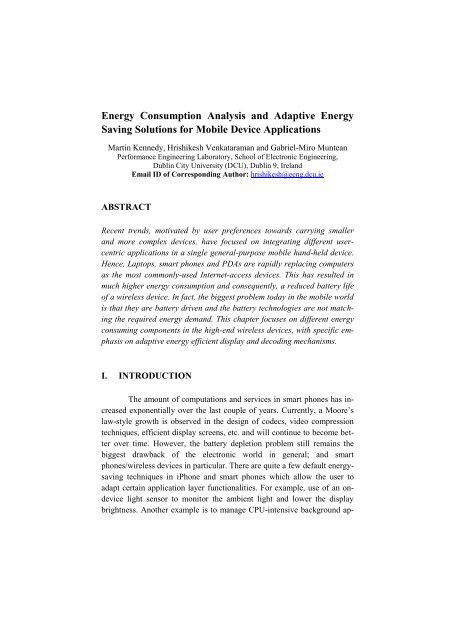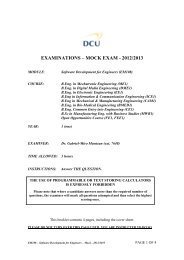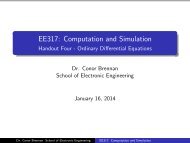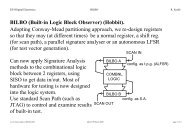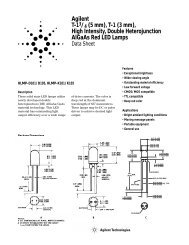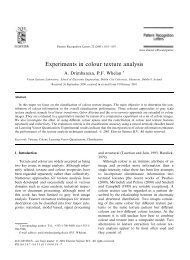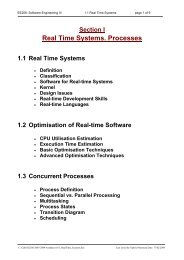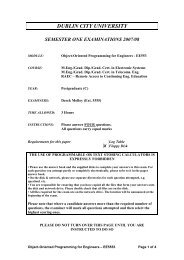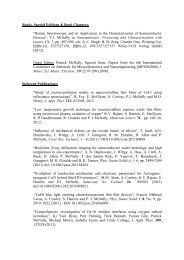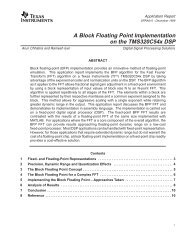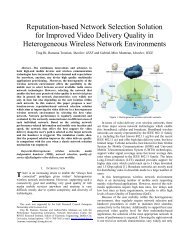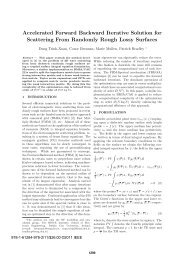Energy Consumption Analysis and Adaptive Energy Saving ... - DCU
Energy Consumption Analysis and Adaptive Energy Saving ... - DCU
Energy Consumption Analysis and Adaptive Energy Saving ... - DCU
You also want an ePaper? Increase the reach of your titles
YUMPU automatically turns print PDFs into web optimized ePapers that Google loves.
<strong>Energy</strong> <strong>Consumption</strong> <strong>Analysis</strong> <strong>and</strong> <strong>Adaptive</strong> <strong>Energy</strong><br />
<strong>Saving</strong> Solutions for Mobile Device Applications<br />
Martin Kennedy, Hrishikesh Venkataraman <strong>and</strong> Gabriel-Miro Muntean<br />
Performance Engineering Laboratory, School of Electronic Engineering,<br />
Dublin City University (<strong>DCU</strong>), Dublin 9, Irel<strong>and</strong><br />
Email ID of Corresponding Author: hrishikesh@eeng.dcu.ie<br />
ABSTRACT<br />
Recent trends, motivated by user preferences towards carrying smaller<br />
<strong>and</strong> more complex devices, have focused on integrating different usercentric<br />
applications in a single general-purpose mobile h<strong>and</strong>-held device.<br />
Hence, Laptops, smart phones <strong>and</strong> PDAs are rapidly replacing computers<br />
as the most commonly-used Internet-access devices. This has resulted in<br />
much higher energy consumption <strong>and</strong> consequently, a reduced battery life<br />
of a wireless device. In fact, the biggest problem today in the mobile world<br />
is that they are battery driven <strong>and</strong> the battery technologies are not matching<br />
the required energy dem<strong>and</strong>. This chapter focuses on different energy<br />
consuming components in the high-end wireless devices, with specific emphasis<br />
on adaptive energy efficient display <strong>and</strong> decoding mechanisms.<br />
I. INTRODUCTION<br />
The amount of computations <strong>and</strong> services in smart phones has increased<br />
exponentially over the last couple of years. Currently, a Moore‟s<br />
law-style growth is observed in the design of codecs, video compression<br />
techniques, efficient display screens, etc. <strong>and</strong> will continue to become better<br />
over time. However, the battery depletion problem still remains the<br />
biggest drawback of the electronic world in general; <strong>and</strong> smart<br />
phones/wireless devices in particular. There are quite a few default energysaving<br />
techniques in iPhone <strong>and</strong> smart phones which allow the user to<br />
adapt certain application layer functionalities. For example, use of an ondevice<br />
light sensor to monitor the ambient light <strong>and</strong> lower the display<br />
brightness. Another example is to manage CPU-intensive background ap-
2<br />
plications. However, these techniques do not provide any step-wise change<br />
<strong>and</strong> real-time change in the energy consumption <strong>and</strong> is an inherent limitation<br />
of the system.<br />
I.A Background<br />
It is predicted that by 2013, mobile devices such as smart phones<br />
<strong>and</strong> PDAs will overtake PCs as the most popular devices used for accessing<br />
the Internet [1]. Most modern mobile phones are capable of playing<br />
video <strong>and</strong> audio, provide high-speed Internet access, enable photography<br />
<strong>and</strong> also support video capturing <strong>and</strong> video streaming. More advanced devices<br />
can interface with GPS systems <strong>and</strong> include additional sensors (for<br />
e.g. accelerometers). While these devices follow a functionality improvement<br />
rate similar to Moore‟s law, developments in battery life have lagged<br />
behind considerably. Panasonic, one of the world‟s leading battery manufacturers,<br />
estimates the annual improvement in the life of their batteries to<br />
be just 11% [2]. In 2011, a Deloitte study explained that progress in battery<br />
life for existing battery technologies is a slow process <strong>and</strong> that big improvements<br />
are observed only when a new battery technology or electrical<br />
storage technology is discovered [3]. A classic example of the gap between<br />
functionality <strong>and</strong> power-supply is the iPhone 4. When used continuously,<br />
for web browsing over 3G, the battery life lasts a mere 6 hours [4].<br />
I.B Current Solutions<br />
Several research works have been carried in recent years to optimize<br />
the required power while simultaneously providing all the requisite<br />
functionalities. The different energy consuming operations are targeted<br />
without causing severe degradation to the user quality-of-experience<br />
(QoE), also defined as the user perception of the quality-of-service (QoS).
i. Specialized Hardware:<br />
3<br />
In a smart phone/high end mobile device, there are several specific hardware<br />
configurations that can be exploited to achieve energy savings. Bahl<br />
et al. [5] investigated a technique using a low-power radio in conjunction<br />
with a regular 802.11 Wireless Network Interface Card (WNIC). One<br />
benefit of this mechanism is that it allows a mobile device <strong>and</strong> its radio to<br />
be powered off, while the low-power radio maintains a network presence<br />
that can be used to wake the device up, in the event of any data reception.<br />
One example where this approach would be effective is voice over IP<br />
(VoIP), where a user can maintain an online presence with minimal b<strong>and</strong>width<br />
<strong>and</strong> only requires a high speed connection while interacting with another<br />
user. Another example is the use of hardware acceleration in video<br />
decoding. Adobe Flash Player has utilized this functionality since version<br />
10.1. The player uses both hardware H.264 decoding <strong>and</strong> hardware graphics.<br />
The main benefit is that by offloading all the processing from device‟s<br />
CPU to purpose designed hardware, the performance <strong>and</strong> energy efficiency<br />
increase dramatically.<br />
ii. Wireless Interface Sleep Mode<br />
The IEEE 802.11 st<strong>and</strong>ard outlines a built-in Power Save Mechanism<br />
(PSM) when operating in infrastructure mode. A simple energy saving<br />
technique is to put the WNIC of a device into sleep mode when it is<br />
not in use [6]. However, it is not always feasible <strong>and</strong> in fact, the savings<br />
depend on the application in use. Multimedia streaming <strong>and</strong> video-ondem<strong>and</strong><br />
applications have different QoS requirements in comparison to<br />
traditional data transmission applications. Saidi et al. [7] have proposed a<br />
battery-aware localization mechanism for the wireless networks wherein<br />
the trade-off between saving energy in a wireless node by lengthening the<br />
sleep-cycle period is investigated while still allowing it to perform accurate<br />
localization calculations. The main issue with this scheme is that it inherently<br />
leads to a lower QoS unless the device knows exactly when it will<br />
receive data.
4<br />
iii. <strong>Energy</strong> efficient Network selection <strong>and</strong> H<strong>and</strong>over<br />
Most mobile devices are currently shipped with multiple heterogeneous<br />
wireless network interfaces, such as Wi-Fi, UMTS, GPRS <strong>and</strong> Bluetooth.<br />
Each of these networks has different energy consumption characteristics.<br />
For instance, in [8] measurements show that the energy consumption<br />
per unit time of communications over a UMTS <strong>and</strong> IEEE 802.11b/g are<br />
similar. However, the energy consumption as a function of the data transferred<br />
can be up to 300 times larger over the UMTS network interface.<br />
Trestian et al. [9] investigated new techniques in order to exploit these energy<br />
characteristics. In this work, a utility function (1) was been proposed<br />
for ordering the vertical/horizontal h<strong>and</strong>over between different networks<br />
within range based on the predicted energy that will be consumed on each<br />
network.<br />
i<br />
w<br />
U<br />
e q c m)<br />
i we<br />
i q i wc<br />
i wm<br />
( u ) *( u ) *( u ) *( u<br />
(1)<br />
Where: i - the c<strong>and</strong>idate network, U - overall utility for network i <strong>and</strong> u e ,<br />
u q , u c , <strong>and</strong> u m are the utility functions defined for energy, quality, monetary<br />
cost <strong>and</strong> user mobility for network i. w e , w q , w c <strong>and</strong> w m are the weights assigned<br />
for each of the four considered criteria.<br />
Mahkoum et al. take another approach <strong>and</strong> propose a power management<br />
framework which enables a device to maintain a network presence<br />
across multiple heterogeneous networks while powering-off all but<br />
one of the network cards on a device [10]. This is similar to that discussed<br />
in [5] but would work with the heterogeneous network interfaces that come<br />
with most modern mobile devices <strong>and</strong> does not require specialized hardware.<br />
The efficiency is achieved by utilizing proxies on each of the heterogeneous<br />
networks to feign the connectivity of the device's network interfaces.<br />
If a connection is made through the proxy for any of the sleeping<br />
network interfaces, the proxy contacts the device's active interface, which<br />
in turn wakes up the interface required.<br />
I.C Limitations of Current Solutions<br />
The above solutions focus on hardware (specialized hardware,<br />
network interface card) <strong>and</strong> network related processing in the device (net-
work selection h<strong>and</strong>over, etc). However, given the numerous functionalities<br />
in a h<strong>and</strong>held wireless device, there are several other avenues in the<br />
device where a significant energy is consumed. These include, audio,<br />
screen, signal processing, efficient information decoding, etc. However,<br />
given the nascent area, there is not enough material <strong>and</strong> not enough analysis<br />
on the energy consumed in the different wireless components. The next<br />
section provides a detailed <strong>and</strong> a comprehensive analysis of different energy-intensive<br />
components in a high-end mobile device/smart phone.<br />
5<br />
II. SYSTEM BASED MODELING AND TESTING<br />
Battery depletion depends on both the hardware <strong>and</strong> software of a<br />
device. The exact amount of energy consumed by each of these components<br />
is dictated by the device characteristics <strong>and</strong> the nature of the applications<br />
running on the device. In order to obtain a comprehensive analysis of<br />
the energy consumption behavior in a high-end wireless device, a specific<br />
device, a HTC Nexus One phone, is considered. This device was selected<br />
because of its wide range of functionality <strong>and</strong> because it runs Android,<br />
which is Open Source. The test system comprises of the Nexus One phone<br />
(running Android 2.1) <strong>and</strong> a video streaming server in a wireless 802.11g<br />
network. The phone is connected to an external measurement setup that<br />
monitors <strong>and</strong> logs its power consumption during the execution of various<br />
tests. These tests, specifically designed for the analysis of the consumption,<br />
include receiving <strong>and</strong> playing video streams over the wireless network<br />
as well as applications to monitor the CPU usage <strong>and</strong> to automatically<br />
change device settings to put the phone into different states (e.g.<br />
changes in the screen brightness).<br />
Fig. 1 shows a smart-phone <strong>and</strong> the potential major energy consuming<br />
components in a h<strong>and</strong>-held device. The power consumption is measured as<br />
shown in Fig. 2. A shunt resistor (1.24 Ω; ± 1%) is inserted between the<br />
phone <strong>and</strong> the battery to allow calculating the current by measuring the<br />
voltage drop across the resistor. The battery voltage is measured <strong>and</strong> multiplied<br />
by the current to obtain the power. All of these voltages are sampled<br />
by an Arduino micro-controller, which logs the instantaneous power-
6<br />
consumption of the device onto a computer. In order to break down the<br />
power consumption, experiments for each component are performed by<br />
changing the parameters of one component while leaving those for the other<br />
components constant. Additional information is provided by Android‟s<br />
battery usage statistics which give a rough indication of the percentage of<br />
battery usage attributed to each of the major consumers. Because of background<br />
processes the CPU usage tends to fluctuate. A background process<br />
is running to push the CPU usage to a constant 100%, which greatly stabilizes<br />
the power consumption in order to get an accurate current reading.<br />
Fig. 1 Smart-phone <strong>and</strong> its different components<br />
Fig. 2 Schematic of a Measurement Set-up
1. The screen is tested by measuring different pairs of brightness levels<br />
<strong>and</strong> pixel colours.<br />
2. The audio consumption is tested by playing the same song at different<br />
volume levels using the speakers <strong>and</strong> earphones.<br />
3. The effects of the network interface <strong>and</strong> the video quality in video<br />
streaming are tested in a single experiment in which the same video is<br />
played using different quality settings once over a wireless network<br />
stream <strong>and</strong> also from a local file.<br />
4. The CPU is tested by running a background service that gradually<br />
changes the CPU activity. Measured power values are then associated<br />
with the different CPU usage levels.<br />
In addition to the data obtained from the experiments which focus on<br />
the dependency of energy consumption on device settings, further tests are<br />
performed in order to break down the overall consumption into the individual<br />
components. This is achieved by finding the minimum <strong>and</strong> maximum<br />
consumption values for each component. The screen energy draw is<br />
calculated by measuring the power of the same process with the screen<br />
enabled first <strong>and</strong> then disabled. By monitoring the CPU usage <strong>and</strong> subtracting<br />
the screen‟s consumption, the power drawn by CPU is obtained.<br />
Given these values, the other components‟ energy draw is easily acquired<br />
by calculating the power difference of the additional draw that is caused<br />
when another component is in use. Fig. 3 shows the measured powered distribution<br />
among the major energy consuming components. The meaning of the minimum<br />
<strong>and</strong> maximum values is explained in Table 1. The dependence of each component‟s<br />
consumption on device settings is discussed as follows.<br />
7<br />
Fig. 3 <strong>Energy</strong> distribution of different components in the Nexus One mobile device
8<br />
CPU<br />
Minimum<br />
CPU usage at 0%<br />
Screen Brightness at 1%,<br />
black pixel color<br />
Audio<br />
Network<br />
Audio playback<br />
muted<br />
Connected to a<br />
WiFi network, idle<br />
Maximum<br />
CPU usage at<br />
100%<br />
Brightness at<br />
100%, white pixel<br />
color<br />
Audio playback at<br />
highest volume using<br />
speakers<br />
Connected <strong>and</strong> receiving<br />
a high<br />
quality video<br />
stream<br />
Table 1. Minimum <strong>and</strong> maximum power values in Nexus One mobile device<br />
II.A <strong>Energy</strong> <strong>Consumption</strong> in Screen<br />
The screen‟s power consumption ranges from about 0.25W to 2W.<br />
For the tests, the red, green <strong>and</strong> blue pixel components were kept at identical<br />
levels; the energy consumption of different colours on the display was<br />
not measured but is discussed in section III.C. The energy consumption<br />
was found to depend on both the brightness level of the screen as well as<br />
the brightness of the pixels‟ colours. From the measurements in Fig. 4, it<br />
can be observed that the consumption increases approximately in linear<br />
fashion with the screen‟s brightness <strong>and</strong> exponentially with the colour<br />
brightness. This is because of the energy characteristics of the particular<br />
OLED display. Hence, the higher the brightness level, the more important<br />
it is to know the average pixel brightness in order to accurately estimate<br />
the power consumption. Without taking the colour into account, the error<br />
of an estimate can be as high as 300% as the power difference between a<br />
black <strong>and</strong> a white screen reaches 1.77W at the highest brightness level.<br />
II.B <strong>Energy</strong> <strong>Consumption</strong> in CPU<br />
The CPU‟s power consumption depends on its usage <strong>and</strong> ranges<br />
from about 50mW to 600mW. The results from four executions of the<br />
same test can be seen in Fig. 5. The power rises with the usage in a linear
fashion but increases sharply at about 80% usage. The exact cause of this<br />
behaviour is unclear but could be a result of increased heat in the device.<br />
Thus, reducing the CPU usage from 70% <strong>and</strong> lower, yields relatively little<br />
power savings compared to a reduction that takes the usage from any value<br />
higher than 80% to any value lower than 70%. However, this assumes that<br />
the usage information provided by the Android API is always accurate.<br />
Nevertheless, the measurements give an indication about the energy saving<br />
potential of the CPU <strong>and</strong> put it into relation with the other components.<br />
9<br />
Fig. 4 Power measurements in the device screen<br />
Fig. 5 Power consumption in CPU
Power (mW)<br />
10<br />
II.C <strong>Energy</strong> <strong>Consumption</strong> in Audio<br />
When playing back audio the power consumption increases from<br />
roughly 135mW at the lowest to 375mW at the highest volume (around<br />
40mW of these values are caused by increased CPU usage). Naturally the<br />
consumption increases with a higher volume but the difference in energy<br />
consumption when playing audio through earphones is rather marginal<br />
whereas the consumption seems to increase exponentially when using<br />
speakers as can be observed in Fig. 6. This implies that the audio interface<br />
offers nearly no savings when earphones are used <strong>and</strong> reducing the volume<br />
in this case to save energy is not advisable.<br />
400<br />
300<br />
Speakers<br />
Earphones<br />
200<br />
100<br />
0<br />
0 1 2 3 4 5 6 7 8 9 10 11 12 13 14 15<br />
Audio Volume [0, 15]<br />
Fig. 6 Power consumption in audio playback<br />
II.D Network <strong>and</strong> the Effect of Video Quality during Streaming<br />
In order to investigate video streaming, the same video clip was<br />
encoded using low <strong>and</strong> high quality settings as in Table 2. In order to deduce<br />
information about both the quality <strong>and</strong> the network effects on the energy<br />
consumption, each clip was played both locally <strong>and</strong> streamed. Fig. 7<br />
puts the measurements for each clip into relation. The power difference between<br />
the low quality <strong>and</strong> high quality video is 255mW for the local playback<br />
<strong>and</strong> 325mW for the stream. The difference is greater for the stream as<br />
a higher quality not only increases the computational power but also the<br />
data rate the stream is received with. The power difference between the local<br />
playback <strong>and</strong> the stream is 305mW for the low quality video <strong>and</strong><br />
372mW for the high quality video. From this it can be seen that the network<br />
interface accounts for about 370mW while receiving the high quality<br />
stream <strong>and</strong> offers savings up to 70mW when the quality is reduced. Qual-
ity reduction also lowers the computational power which results in savings<br />
up to 255mW. No absolute power increase for video playback is given because<br />
the screen‟s consumption during playback is unknown. The average<br />
pixel color brightness would have to be calculated for each frame to estimate<br />
the screen‟s consumption.<br />
11<br />
Codec<br />
Video<br />
bitrate<br />
Low Quality(LQ) High Quality(HQ)<br />
MPEG-4 MPEG-4<br />
128 kbps 1536 kbps<br />
FPS<br />
10 frames/<br />
second<br />
23 frames/<br />
second<br />
Dimensions<br />
200 x 120 px 800 x 480 px<br />
Audio<br />
bitrate<br />
32 kbps 128 kbps<br />
Table 2 Video encodings used<br />
II.E <strong>Analysis</strong> of Solutions<br />
Fig. 7 Video playback comparison<br />
As can be seen in Fig. 3, the components of a mobile device that<br />
consume the most energy are the screen, the network interfaces <strong>and</strong> the
12<br />
CPU [11]. From our measurements, it has been estimated that it takes the<br />
battery of Nexus One approximately 16 hours to deplete fully (with moderate<br />
usage 1 ). This in itself is not a very long period of time but it implies<br />
that the device will function approximately one business day before requiring<br />
a recharge. In contrast though, if an energy intensive application is<br />
running non-stop on the device, such as a video streaming app, the battery<br />
will deplete in as little as four hours (using Wi-Fi). This would simply not<br />
be acceptable for a device that also acts as the owner‟s point of contact for<br />
the whole day. Over the recent years (2009 <strong>and</strong> 2010), several battery saving<br />
software solutions have been launched. These application layer based<br />
solutions are designed for specific operating systems (OSs) <strong>and</strong> provide<br />
some basic energy saving features in smart-phones:<br />
1. “<strong>Energy</strong>-Saver” developed by Fedoroff Soft, USA [12] <strong>and</strong> focuses<br />
mainly on auto switch OFF <strong>and</strong> ON during night/unused time. It is<br />
available for the last 12 months at a price of 4.95 Euros.<br />
2. “Green-Phone” application developed by Mobi-Monster [13]. Green-<br />
Phone offers few features like energy savings in the backlight display<br />
mechanism <strong>and</strong> automatic charger disconnection after charging. It supports<br />
Windows Mobile <strong>and</strong> is highly successful commercially. However,<br />
it does not provide any adaptive energy savings.<br />
3. “Power Manager” is an application developed by X-Phone [14]. It adds<br />
basic dynamic power settings to the phone, like how long the screen is<br />
on during a call, if device stays on while the keyboard is open, etc. It<br />
automatically changes several settings of the device as a group. It is one<br />
of the most sought after Apps in Android but unfortunately, does not<br />
cater specifically to graphic-intensive battery drain in the device.<br />
4. “Power Control Plus” currently available only in Android phones is a<br />
widget that lets you turn on/off more than 30 settings in the device [15].<br />
This is a great mobile App but requires quite an amount of manual settings.<br />
It cannot <strong>and</strong> does not provide for any adaptive energy savings in<br />
the device middleware.<br />
1<br />
30 minutes 3G talk-time, Wi-Fi <strong>and</strong> Synchronization enabled, 3 hours audio playback, 40 minutes<br />
browsing over Wi-Fi Interface, GPS <strong>and</strong> Bluetooth Disabled, 30 minutes game-play.
5. “Green Mode 2.0” is an app concept for iPhone [16] that explores the<br />
idea of switching off active functions <strong>and</strong> other apps when the user does<br />
not need them. It highlights the energy consumption of various Apps<br />
<strong>and</strong> functions <strong>and</strong> allows the user to manage their battery budget. It currently<br />
only supports ON/OFF behaviour (similar to „<strong>Energy</strong> Saver‟).<br />
However, the biggest drawback of the aforementioned five energy<br />
saving applications is that none of the solutions go beyond the application<br />
layer. Importantly, the adaptive energy savings in decoding, display<br />
screen, etc. that can be bought in the device need to go beyond the application<br />
layer, into the protocol stack <strong>and</strong> the middleware design. Hence, there<br />
is a need for further research in these aspects. The next section targets<br />
three energy saving aspects in a high-end device. These are:<br />
a. <strong>Adaptive</strong> streaming<br />
b. Dynamic decoding<br />
c. Dynamic screen control<br />
13<br />
III.<br />
Research Directions Towards <strong>Adaptive</strong> Schemes<br />
This section describes in detail the adaptive mechanism <strong>and</strong> energy savings<br />
in each of the three aforementioned approaches, along with the different<br />
challenges that need to be addressed in the future.<br />
III.A <strong>Adaptive</strong> Streaming<br />
<strong>Adaptive</strong> streaming is the process whereby the quality of a multimedia<br />
stream is altered in real-time while it is being sent from server to<br />
client. This adaptation of quality is decided in decision modules on either<br />
the client or server. The adaptation may come as a result of weighing different<br />
network or device metrics, for example, with a decrease in network<br />
throughput, an adaptation to a lower quality of video may improve the<br />
QoS. <strong>Energy</strong> relevant metrics can also be considered in order to decide<br />
whether an adaptation would be beneficial or not. <strong>Energy</strong> savings are<br />
achieved on the WNIC because less data is being received over the interface.<br />
Additionally this opens up a larger window of free time that can be<br />
used to put the WNIC in sleep mode more frequently.
14<br />
The functionality to serve adaptive video streams has become far<br />
more available in recent years, since Microsoft Silverlight, <strong>and</strong> subsequently<br />
Adobe Flash, began supporting it. Flash‟s HTTP dynamic streaming<br />
is of particular interest to the mobile device field now though since<br />
they began rolling out Flash player 10.1 for Android, BlackBerry, webOS,<br />
Windows Phone, LiMo, MeeGo <strong>and</strong> Symbian OS in 2010. Even though<br />
Flash has not been considered energy efficient in the past, version 10.1<br />
was completely overhauled with energy conservation in mind [17]. Version<br />
10.2 of the player has just been released for desktop computers <strong>and</strong><br />
preliminary tests show that it is up to 34 times more efficient than version<br />
10.1 [18]. As a result, Flash is quickly becoming a viable alternative for<br />
consuming video streams in an energy-aware way.<br />
An emerging platform-independent video streaming technology is<br />
HTML5, which now comes with a tag. While it is currently possible<br />
to use this technology to stream videos natively in HTML pages, the<br />
functionality of the tag is still very limited. Internet Explorer does<br />
not support HTML5 yet. Not only that but different browsers are choosing<br />
to support different video codecs, which means multiple versions of<br />
streams are necessary for universal browser support. There is no support<br />
for dynamic streaming yet. Having said that, the development of HTML5<br />
will be extremely interesting; it may eventually provide significant benefits<br />
over Flash as an energy-efficient streaming mechanism. In [19], Venkataraman,<br />
et al. proposed <strong>and</strong> developed a simple algorithm that analyses the<br />
remaining stream-duration <strong>and</strong> the remaining battery-life in order to decide<br />
whether or not to send an adaptation order to the dynamic streaming<br />
server. When the remaining stream duration exceeds the remaining battery<br />
life, the video quality is adapted. This is the simplest example of an energy-aware<br />
dynamic streaming mechanism for video. In order to improve<br />
upon this algorithm, additional metrics need to be considered for efficient<br />
dynamic streaming in real-time. This is very much an open problem <strong>and</strong><br />
still needs considerable research work.<br />
III. B Dynamic Decoding<br />
Dynamic decoding refers to operations on the client device that alter<br />
the default decoding process in real-time in order to maximize energy
efficiency when required. This can involve simplifying the decoding process<br />
or parsing metadata to concentrate the decoding process on important<br />
regions in the screen, image or video.<br />
Scalable Video Coding (SVC) is an extension to the<br />
H.264/MPEG-4 video st<strong>and</strong>ard. It details a mechanism for decoding an<br />
SVC video stream dynamically at one of multiple quality levels [20]. The<br />
dynamic scaling is achieved through any combination of three scaling<br />
mechanisms:<br />
1. Temporal Scalability: Changing the frame-rate of the received video<br />
stream by dropping whole frames. In MPEG videos, B-Frames can be<br />
dropped without affecting any of the previous or following frames in a<br />
Group of Pictures.<br />
2. Spatial Scalability: Changing the resolution of the video.<br />
3. Quality Scalability: Changing the quantization parameter for each<br />
macro-block in the video decoder. This has been proven to yield a 42%<br />
decrease in energy consumption during video-decoding with a mere<br />
13% quality degradation in the video [21].<br />
A Region of Interest (RoI), in video terminology, is classified as<br />
an area of a video frame that attracts the most amount of attention from<br />
viewers. As an example, while watching a football match, the viewer may<br />
be most interested in looking at the area around the football (though this<br />
may not be the case for everybody). There are several methods for discovering<br />
the RoI in a video sequence, which include eye-tracking (with cameras),<br />
<strong>and</strong> video processing <strong>and</strong> analysis. However, these are not very practical<br />
on a battery-powered device as they would consume too much energy<br />
for mobile devices. An alternative to this would be to find the RoI on the<br />
streaming server itself, which could then transmit RoI metadata alongside<br />
the video. Ji et al. have shown how RoI processing can be combined with<br />
quality scalability to maximize energy-savings <strong>and</strong> QoE [22]; up to a 15%<br />
energy reduction can be achieved with minimal degradation in video quality.<br />
In fact, in this chapter, the RoI is assumed to be the centre of each<br />
video frame. While this assumption can be tolerated to initially explore<br />
whether energy savings may be obtained from RoI-aware decoding, a more<br />
advanced system would be required for determining the RoI in a real ap-<br />
15
16<br />
plication [23]. Additionally, the proposed algorithm for implementing the<br />
decoding adaptations does not make use of temporal scalability or spatial<br />
scalability. It would be interesting to see if the adaptation of the video<br />
stream on the server could be performed using SVC <strong>and</strong> RoI mechanisms<br />
to maximize the QoE-to-bit-rate ratio. This is a significant research challenge<br />
that would have to be addressed in the coming years.<br />
III.C Dynamic Screen Control<br />
As has been shown in our study in Section II, the display screen is<br />
one of the largest energy consuming components on a mobile device. It<br />
also yields the largest range for energy saving possibilities. Different<br />
screen technologies have very different energy consumption characteristics.<br />
Unlike older LCD screens, OLED displays do not require a backlight<br />
as their pixels are light-emitting. In an LCD display, the backlight accounts<br />
for the majority of the device‟s power draw. For OLED devices, energy<br />
consumption depends on intensity <strong>and</strong> chromaticity of each pixel being<br />
displayed. As a result, OLED devices consume almost no power when displaying<br />
black pixels but consume far more than an LCD when displaying<br />
white pixels.<br />
Dong et al. have done significant research in this domain. They<br />
were the first to begin research on manipulating the colours of pixels on<br />
OLED screens in order to conserve energy on mobile devices [24]. The<br />
first step was to create a model for an OLED device so that an optimal solution<br />
can be achieved. This involved devising a device independent<br />
mechanism for assessing, pixel-by-pixel, the energy required in order to<br />
display each of all the available colours on the OLED screen. This is quite<br />
a long <strong>and</strong> computationally intensive process to be performed in an iterative<br />
fashion. Hence, the authors created a shortened <strong>and</strong> simplified approximation<br />
algorithm. The new algorithm decreased the computational<br />
cost of the calculation by 1600 times while still achieving 90% accuracy.<br />
Having devised the algorithm above, Dong et al. then investigated<br />
using colour transformations. In [25], the current colours of the different<br />
GUI themes are assessed in terms of their energy efficiency. They are then<br />
altered to different colours which maintain the overall contrasts of the different<br />
colours on the page while providing significant energy savings. En-
ergy reductions of over 75% were achieved on the display while still<br />
showing a GUI to users that they felt comfortable using. In [26], the same<br />
authors succeeded in combining all of the work from their previous two<br />
papers in order to create a fully functional Android application. The application<br />
creates an energy-colour model of the device‟s OLED screen <strong>and</strong><br />
then uses it to perform colour transformations to websites. The application,<br />
Chameleon, reduced the total system power consumption by over 41%<br />
during web-browsing. It would be interesting to perform mild colouradaptations<br />
to videos which may have a significant effect on power consumption<br />
without compromising the user‟s QoE.<br />
III.D Additional Techniques<br />
The list of techniques explained above is not exhaustive. Other approaches<br />
include dynamic background-process control, limiting CPU utilization,<br />
energy efficient routing <strong>and</strong> data caching, <strong>and</strong> energy efficient<br />
cooling techniques. For all of these energy-saving techniques future research<br />
will be concerned with the constructive combination of as many approaches<br />
as possible to optimize the energy consumption while maximizing<br />
the QoE. Design of a comprehensive energy-saving algorithm is<br />
discussed in more detail in the next section (IV).<br />
17<br />
IV. Context-Aware Algorithm Design<br />
Context-aware energy-conscious computing is the process of recording<br />
inputs from various metrics <strong>and</strong> sensors available on a mobile device.<br />
These data in conjunction with past data are then fed into a utilityfunction<br />
which adapts <strong>and</strong> learns from past experiences in order to maximize<br />
the user‟s QoE while maximising the energy savings in a device. An<br />
important point about context-aware computing is that the aim is to find an<br />
optimal <strong>and</strong> complete solution by combining all available mechanisms.<br />
Vallina-Rodriguez et al. conducted a study where-by the day-to-day interaction<br />
of 20 subjects with their <strong>and</strong>roid devices was recorded for analytical<br />
purposes [26]. The goal was to investigate whether the users‟ interactions<br />
with mobile devices could be modelled easily in order to algorithmically<br />
create a unified energy conservation mechanism. Statistics about the CPU,
18<br />
memory, battery, network interfaces, the screen <strong>and</strong> other sensors were<br />
logged on each user's device. The authors concluded that as a result of<br />
widely varying user-device interaction behaviour, that static-algorithmic<br />
control of the device's resources is an insufficient approach.<br />
There are three steps that must be taken in order to design a context-aware<br />
energy-conscious solution for mobile devices. Firstly, the lossof-quality-of-experience-to-energy-savings<br />
ratio of each mechanism <strong>and</strong><br />
combination of mechanisms outlined above must be evaluated in a range<br />
of different real-life situations. This entails designing <strong>and</strong> conducting significant<br />
user testing in order to gather enough information to model how<br />
each mechanism <strong>and</strong> combination of mechanisms perform in relation to<br />
each other. This model will later be used for selecting the combinations of<br />
mechanisms to be used in order to achieve the energy savings required on<br />
the mobile device. The lower the ratio is, the higher the mechanism‟s efficiency<br />
in terms of reducing the energy consumption while maximising the<br />
QoE. Testing similar to this as this can be seen in [27] where the authors<br />
describe the GUIs investigated in terms of user popularity <strong>and</strong> energyreductions.<br />
The ratio calculation is an extension of this work. Secondly, a<br />
utility-function for assessing the residual power of the mobile device in the<br />
context of its current application must be created. This involves considering<br />
application-specific QoS requirements, the current rate of energy consumption,<br />
past experience, user preferences <strong>and</strong> predictions formed from<br />
the collection <strong>and</strong> analysis of past data. The utility function will give the<br />
system utility, U, which can then be assessed (using thresholds) in order to<br />
select the most effective of the mechanisms/combinations above. Finally,<br />
the algorithm must maintain a cache of device usage statistic <strong>and</strong> trends.<br />
This data is required for dynamic alteration of utility function weights <strong>and</strong><br />
the threshold values in order to ensure the optimality of the solution. This<br />
step is where the algorithm becomes context-aware by conducting realtime<br />
learning <strong>and</strong> behaviour-monitoring.<br />
V. Summary<br />
This chapter provides a comprehensive insight into the energy<br />
consumption behaviour in a smart phone/high-end mobile device. In order
to measure the energy consumption across the different functionalities <strong>and</strong><br />
computations across the device, a particular model – an Android based<br />
HTC Nexus One phone has been used for extensive testing. Of the different<br />
components – the WNIC, display screen <strong>and</strong> the CPU are the most significant<br />
in terms of energy consumption, while the audio component consumes<br />
a negligible amount of energy. Furthermore, even though there are<br />
different energy saving mechanisms currently in the literature, there is a<br />
fundamental problem in the energy consumption space that is completely<br />
overlooked – i.e., there are no sophisticated adaptive processes in the device<br />
that prolong the battery life in real-time, depending on the nature of<br />
application <strong>and</strong> current battery level. Even though the energy saving<br />
mechanisms have improved considerably over the years, a dynamic adaptation<br />
<strong>and</strong> seamless increase in the battery life is still offered nowhere. Importantly,<br />
this chapter demonstrates that by investigating deeper into the<br />
protocol stack <strong>and</strong> by modifying the middleware design in the mobile terminal,<br />
significant <strong>and</strong> yet, context-aware energy savings can be obtained in<br />
the streaming, decoding <strong>and</strong> display components of the h<strong>and</strong>held device,<br />
by using appropriate mechanisms.<br />
19<br />
References<br />
[1] Gartner Inc., Gartner‟s Top Predictions for IT Organizations <strong>and</strong> Users, 2010 <strong>and</strong> Beyond:<br />
A New Balance. 2009.<br />
[2] H. Kume, “Panasonic‟s New Li-Ion Batteries Use Si Anode for 30% Higher Capacity,”<br />
http://techon.nikkeibp.co.jp/article/HONSHI/20100223/180545[Accessed: 04-May-2010]<br />
[3] Deloitte, Squeezing the electrons in: batteries don‟t follow Moore's Law. 2011.<br />
[4] Apple Inc., “Apple (Republic of Irel<strong>and</strong>) Technical specifications of iPhone 4.” [Online].<br />
Available: http://www.apple.com/ie/iphone/specs.html. [Accessed: 08-Apr-2011].<br />
[5] P. Bahl, A. Adya, J. Padhye, <strong>and</strong> A. Walman, “Reconsidering wireless systems with multiple<br />
radios,” ACM SIGCOMM Computer Communication Review, vol. 34, no. 5, 2004.<br />
[6] R. Kravets <strong>and</strong> P. Krishnan, “Application-driven power management for mobile communication,”<br />
ACM Wireless Networks, vol. 6, no. 4, p. 263–277, 2000.<br />
[7] A. Saidi, C. Zhang, S. Chiricescu, L. J. Rittle <strong>and</strong> Y. Yu, “Battery-Aware Localization in<br />
Wireless Networks,” Proceedings of IEEE Local Computer Networks Zürich, Switzerl<strong>and</strong>,<br />
October 2009.<br />
[8] H. Pet<strong>and</strong>er, “<strong>Energy</strong>-aware network selection using traffic estimation,” in Proceedings<br />
of the 1st ACM workshop on Mobile internet through cellular networks, 2009, p. 55–60.<br />
[9] R. Trestian, O. Ormond, <strong>and</strong> G. M. Muntean, “Power-friendly access network selection<br />
strategy for heterogeneous wireless multimedia networks,” in Broadb<strong>and</strong> Multimedia<br />
Systems <strong>and</strong> Broadcasting (BMSB), 2010 IEEE International Symposium on, 2010, p.1-5<br />
[10] H. Mahkoum, B. Sarikaya, <strong>and</strong> A. Hafid, “A framework for power management of h<strong>and</strong>held<br />
devices with multiple radios,” in Wireless Communications <strong>and</strong> Networking Conference,<br />
2009. WCNC 2009. IEEE, 2009, p. 1–6.
20<br />
[11] D. Theurer, M. Kennedy, H. Venkataraman <strong>and</strong> G.-M. Muntean, “<strong>Analysis</strong> of Individual<br />
<strong>Energy</strong> Consuming Components in a Wireless H<strong>and</strong>held Device,” China-Irel<strong>and</strong> International<br />
Conference on ICT", Wuhan, China, 2010.<br />
[12] “FedoroffSoft. T-Reminder <strong>and</strong> <strong>Energy</strong> Saver official site.” [Online]. Available:<br />
http://www.fedoroffsoft.com/. [Accessed: 10-Apr-2011].<br />
[13] “MobiMonster2.0 :: Business <strong>and</strong> Personal utility software for your Mobile.” [Online].<br />
Available: http://www.mobimonster2.com/. [Accessed: 10-Apr-2011].<br />
[14] “Power Manager.” http://www.xphonesoftware.com/pm.html. [Accessed: 09-Mar-2011].<br />
[15] http://www.appbrain.com/app/power-control-plus-<br />
(widget)/com.siriusapplications.eclairwidgets. [Accessed: 10-Apr-2011].<br />
[16] http://www.thegreenswitch.org/wp-content/uploads/2010/05/Green-Mode-App-V2.0.pdf.<br />
[17] Microsoft Inc., “Developing <strong>Energy</strong> Smart Software Case Study - Adobe Flash Player.” .<br />
[18] T. Nguyen, “Flash Player 10.2 is Here: Available Now for Windows, Mac, <strong>and</strong> Linux,”<br />
Available: http://blogs.adobe.com/flashplayer/2011/02/flash-player-10-2-launch.html.<br />
[19] M. Kennedy, H. Venkataraman <strong>and</strong> G.-M. Muntean, “Battery <strong>and</strong> Stream-Aware <strong>Adaptive</strong><br />
Multimedia Delivery for H<strong>and</strong>held Devices” in IEEE Local Computer Networks<br />
Denver, USA, October 2010.<br />
[20] A. M. Alt <strong>and</strong> D. Simon, “Control strategies for H. 264 video decoding under resources<br />
constraints,” in Proceedings of the Fifth International Workshop on Feedback Control<br />
Implementation <strong>and</strong> Design in Computing Systems <strong>and</strong> Networks, 2010, p. 13–18.<br />
[21] S. Park, Y. Lee, J. Lee, <strong>and</strong> H. Shin, “Quality-adaptive requantization for low-energy<br />
MPEG-4 video decoding in mobile devices,” Consumer Electronics, IEEE Transactions<br />
on, vol. 51, no. 3, p. 999–1005, 2005.<br />
[22] W. Ji, M. Chen, X. Ge, P. Li, <strong>and</strong> Y. Chen, “ESVD: Integrated energy scalable framework<br />
for video decoding”, Journal on Wireless Communications <strong>and</strong> Networking, 2010.<br />
[23] D. Grois, E. Kaminsky, <strong>and</strong> O. Hadar, “Dynamically adjustable <strong>and</strong> scalable ROI video<br />
coding,” in Broadb<strong>and</strong> Multimedia Systems <strong>and</strong> Broadcasting (BMSB), 2010 IEEE International<br />
Symposium on, 2010, p. 1–5.<br />
[24] M. Dong, Y. S. K. Choi, <strong>and</strong> L. Zhong, “Power modeling of graphical user interfaces on<br />
OLED displays,” in IEEE/ACM Design Automation Conference, 2009. p. 652–657.<br />
[25] M. Dong, Y. S. K. Choi, <strong>and</strong> L. Zhong, “Power-saving color transformation of mobile<br />
graphical user interfaces on OLED-based displays,” Proceedings of the 14th ACM/IEEE<br />
international symposium on Low power electronics <strong>and</strong> design, 2009, p. 339–342.<br />
[26] N. Vallina-Rodriguez, P. Hui, J. Crowcroft, <strong>and</strong> A. Rice, “Exhausting Battery Statistics,”<br />
Proceedings of ACM Mobiheld, 30 th August 2010, New Delhi, India.<br />
[27] M. Dong <strong>and</strong> L. Zhong, “Chameleon: A Color-<strong>Adaptive</strong> Web Browser for Mobile OLED<br />
Displays,” Arxiv preprint arXiv:1101.1240, 2010.<br />
.


